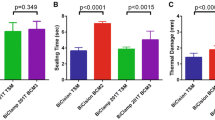Abstract
Introduction: Hemostasis is of utmost importance in urologic cancer surgery. The aim of this initial case-controlled study was to evaluate the use of an electrothermal biporal coagulator (Ligasure device) in major urologic procedures, including open radical prostatectomies and radical cystectomies. Materials and methods: Over the years 2001 to 2002, 58 patients patients aged 56–74 years (mean: 65 years) underwent open radical prostatectomies and open radical cystectomies performed by the same surgeon, employing either conventional ligation in the control group (radical prostatectomy, n = 15; radical cystectomy n = 9) or the Ligasure device in the study group (radical prostatectomy, n = 24; radical cystectomy n = 10) to ensure blood vessel patency. Effectiveness and postoperative outcomes were evaluated. Results: The 2 groups were similar regarding demographic and clinical variables. The mean operation time was significantly shorter in the Ligasure group compared with the control group for both the prostatectomy (125 minutes vs. 144 minutes, p < 0.001) and the cystectomy procedures (253 minutes vs. 281 minutes, p < 0.001). The mean intra-operation blood loss was significantly lower in the Ligasure group compared with the control group for both prostatectomy (569 ml vs. 685 ml, p = 0.04) and cystectomy procedures (637 ml vs. 744 ml, p = 0.02). Intraoperative blood transfusion was only required in 2 patients (1 radical prostatectomy, 1 radical cystectomy) in the Ligasure group and in 7 patients in the control group respectively (p = 0.01). There was no effect of surgical specimen size on operation time for both prostatectomy (r = -0.03, p = 0.8, n = 39) and cystectomy procedures (r = 0.02, p = 0.9, n = 19). There were no serious intra-operation or postoperative complications related to the use of the Ligasure device. Conclusions: Ligasure radical prostatectomy and radical cystectomy are safe, and significantly decrease both the operation time and the blood loss, when compared to the conventional ligation method.
Similar content being viewed by others
References
Busch OR, Hop WC, Hoynck van Papendrecht MA et al. Blood transfusions and prognosis in colorectal cancer. New Engl J Med 1993; 328: 1372–1376.
Oefelein MG, Colangelo LA, Rademaker AW et al. Intraoperative blood loss and prognosis in prostate cancer patients undergoing radical retropubic prostatectomy. J Urol 1995; 154: 442–447.
Parekh DJ, Gilbert WB, Koch MO et al. Continent urinary reconstruction versus ileal conduit: a contemporary singleinstitution comparison of perioperative morbitity and mortality. Urology 2000; 55: 852–855.
Hanash KA, Peracha AM, Al-Zahrani HM et al. Radical cystectomy: minimizing operation blood loss with a “stapling technique”. Urology 2000; 56: 488–491.
Park KI, Kojima O, Tomoyoshi T. Intra-operative autotransfusion in radical cystectomy. Br J Urol 1997; 79: 717–721.
Douglas TH, Mc Leod DG. Modification of the surgical technique in radical cystectomy. Tech Urol 1996; 2: 73–76.
Kennedy JS, Stranahan PL, Taylor KD et al. High-burststrength, feedback-controlled bipolar vessel sealing. Surg Endosc 1998; 12: 876–878.
Nelson MT, Nakashima M, Mulvihill SJ. How secure are laparoscopically placed clips? Arch Surg 1992; 127: 718–720.
Stranahan PL, Buysse SP, Ryan TP. Healing Process and Histologic Evaluation Following Use of Bipolar Energy for Vessel Sealing. Boulder, Colorado, USA: Valleylab, a Division of Tyco Healthcare Group LP, 1999.
Kennedy JS, Buysse SP, Lawes KR. Recent innovations in bipolar electrosurgery. Minimally Invasive Therapy and Allied Technologies 1999; 8: 95–99.
Landman J, Kerbl K, Rehman J et al. Evaluation of a vessel sealing system, bipolar electrosurgery, harmonic scalpel, titanium clips, endoscopic gastrointestinal anastomosis vascular staples and sutures for arterial and venous ligation in a porcine model. J Urol 2003; 169: 697–700.
Grawford ED, Kennedy JS, Sieve V. Use of the Ligasure vessel sealing system in urologic cancer surgery. Grand Round Urol 1999; 1: 10–17.
Romano F, Caprotti R, Franciosi C et al. Laparoscopic splenectomy using ligasure. Surg Endosc 2002; 16: 1608–1611.
Sengupta S, Webb DR. Use of a computer-controlled bipolar diathermy system in radical prostatectomies and other urological surgery. ANZ J Surg 2001; 71: 538–540.
Author information
Authors and Affiliations
Corresponding author
Rights and permissions
About this article
Cite this article
Daskalopoulos, G., Karyotis, I., Heretis, I. et al. Electrothermal bipolar coagulation for radical prostatectomies and cystectomies: A preliminary case-controlled study. Int Urol Nephrol 36, 181–185 (2004). https://doi.org/10.1023/B:UROL.0000034655.42081.9f
Issue Date:
DOI: https://doi.org/10.1023/B:UROL.0000034655.42081.9f




